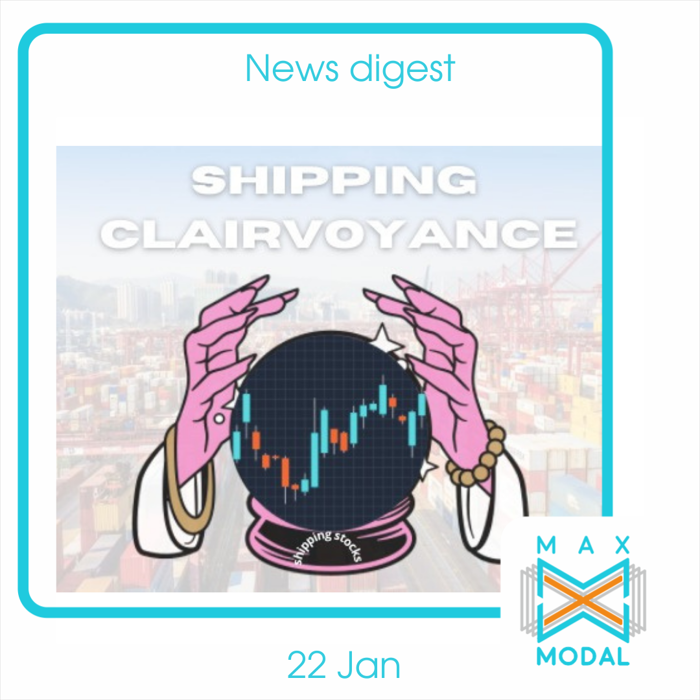News digest. 22 Jan
It seems like the more we analyze, the more uncertainty gets revealed: is there a new course for shipping stocks or are we just trying to bet on the future?
The unsustainable situation regarding shipping rates is creating even more uncertainty for container stocks. It is a double edge sword - players are excited for the situation to ease (eventually) but at the same time, the roll-in rates and discounting it are always ahead of time. For example, in early cycles, experts in the industry will discount peak valuations and peak earnings and put more emphasis on what they expect to be more normalized midcycle earnings. But as we all know, any indicators about how the future will unfold have been very elusive, and so far it seems that the supercycle will persist. So far, experts report that a lot of positivity has been priced in and they suppose that once things start to turn, players will begin to discount the substantial fleet growth that’s coming into the market in 2023 and 2024. Another contributing factor is how disciplined and tamed the market will be in terms of controlling rate increases. With shipping lines winning the pandemic and them clearly profiting from the challenging context, they do not feel the need to slow down and contribute to return to the “normal” rates. However, there is no guarantee that this permissiveness will last for long. The recent example of South Korea demonstrates that antitrust bodies are after big alliances. But at the same time, big companies are vigorously eliminating any sort of competitors, especially when it comes to small forwarders; Maersk is trying to establish its reign with its space ban. As capacity has become a new gold, everyone’s main objective is to have their cargo shipped. With the new Maersk's policy they can get spot rates only, which means they cannot plan a shipment. Small players simply can never find a space with Maersk, and at the same time, they cannot secure long-term contracts with other lines. For many it means the end, for medium forwarders it means a dark future to say the least. The situation is topped with the lack of containers that are affecting reefer shippers and their import partners. Reefer rates are also on the rise, and as a result, it causes the threat of having fewer and fewer products on the shelves. The food sector, just like any other, is suffering from a tremendous rise in supply chain costs due to congestion and is reconsidering its supplier relations. The construction sector is set to do the same with some companies already diving into diversification of their suppliers and reducing SKUs. This only further proves the strategic decision of Tesco to continue supplying its products by train as the only available alternative. COSCO Shipping follows suit and launches a train service for Jimo Port Station for its electrical goods that used to be transported by sea.
Containerships continue overflooding ports living up the last year's predictions that the situation will persist all the way to 2022. Yantian had to restrict container entry to ease overflow, while such a busy Chinese port as Shenzhen is still suffering from severe congestion complicated by the city's partial lockdowns. Overall, the perplexing situation in Asia is pushing even the big lines to reconsider their priorities. While we saw a major trend for acquisitions in the west, Taiwanese liner operators (Evergreen, Yang Ming, and Wan Hai) have chosen to focus on their core business instead of aiming for the expansion of the logistics sector. They already have their subsidiaries, so there is no need to get into the other sector just for the aimless sake of strengthening their positions. Meanwhile, the US fourth largest Port of Hueneme has started chattering vessels with FedEx as an alternative to transpacific service as it successfully omits congested Porst of LA and Long Beach, where there is no light at the end of the tunnel, especially since shippes are facing the new obstacles due to the increasing trucking rates. In contrast, in the EU there are also improvements port-wise. The new data has shown that despite all the challenges, the Port of Antwerp is back to pre-pandemic levels. The port’s container traffic held steady in 2021, processing over 12 million TEU. The positive dynamic has allowed the port to get into the initiative of merging with the Port of Zeebrugge in Belgium. The former is an important chemical transshipment center, while the latter is Europe’s largest car import port and a vital LNG supply port, so no violation of competition will take place. On the contrary, the merge of two powerful facilities will have a complementary character.
Although the destiny of the railway between North Korea and China remains covered in hues, there are optimistic updates that the traffic has resumed, despite the doubts of some media that the decision is temporary. Reportedly, Chinese traders are already gearing up to load more of the much-demanded goods, in anticipation of the next train. In the meantime, Russia hops on the green train of sustainable development and in unison with other companies seconds that the transition depends on the right infrastructure development. Hence it is currently building a fleet of new hydrogen-based freight locomotives with RZD being a potential customer. For the overall infrastructure development, the country is also planning to build a new container terminal at the Port of Olya in Astrakhan to gain more access to the Caspian

